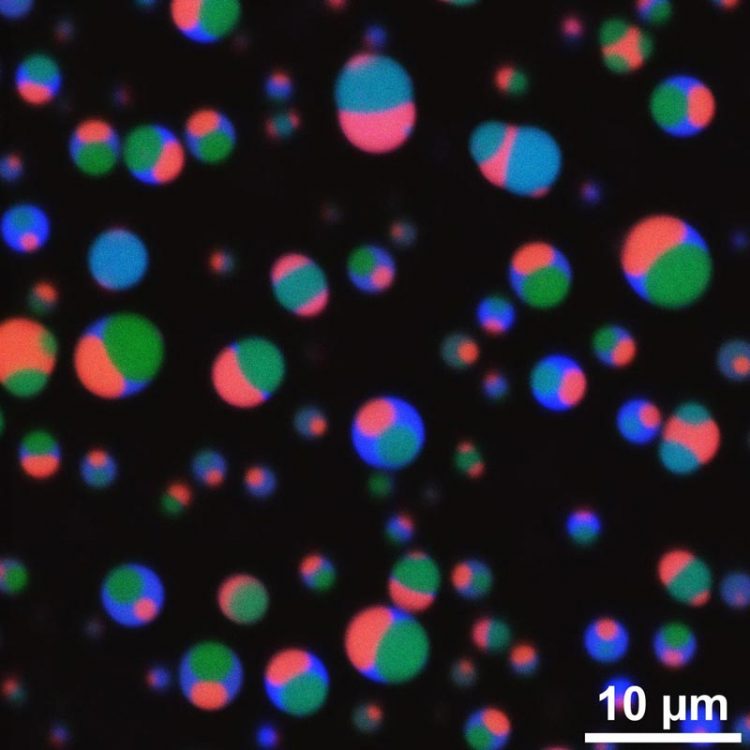Compartments without borders

A new method by researchers at Penn State allows the creation of compartments within a liquid that do not have physical barriers, which could improve understanding of compartmentalization in biological systems. In this false colored fluorescence microscopy image, multi-compartment polymer-rich droplets were created in a water-based environment. Three of the six polymers used to create the droplets in this system are fluorescently labeled, therefore the color of each compartment describes its composition. Credit: Keating Lab, Penn State
A new laboratory method allows researchers to create compartments within a liquid that, like drops of oil in water, are separate but have no physical barrier between them.
The method could help researchers understand how human cells use similar “membraneless compartments” to segregate and concentrate components for important cellular processes, chemical reactions, or other biological functions.
Researchers at Penn State developed and used the method to create complex multi-sectioned compartments and compartments within compartments, all without any physical dividers or membranes. Their results are published in a paper that appears online in the journal Biomacromolecules.
“A cell has a variety of compartments or containers, like the nucleus and mitochondria, with membranes that separate their contents from the rest of the cell,” said Gregory Mountain, graduate student at Penn State and an author of the study.
“These compartments help the cell perform different tasks in different locations. But researchers are continuing to discover compartments within the cell that lack physical outer membranes and that can form and then dissolve as needed. Disruption of these membraneless compartments has been implicated in diseases such as ALS, Alzheimer's, and Type II Diabetes.”
Membraneless compartments within cells result from the separation of molecules like proteins and RNA into different liquid phases. To create membraneless compartments in the lab, the researchers combined simplified charged polymers of repeating amino acids and/or nucleic acids in water. The polymers were fluorescently labeled, which allowed the researchers to monitor the resulting interactions.
As the charged polymers interacted, with opposite charges attracting, separate compartments formed in the liquid with no physical dividers. Combining four polymers allowed the researchers to produce droplets with two compartments as well as compartments-within-compartments. Combining six polymers produced droplets with three compartments.
“This straightforward method allows us to understand the basic chemistry of how multi-phase compartments could form and dissolve within a cell,” said Mountain. “Then we can build up the complexity. Factors like temperature, salt concentration, acidity, and charge strength of the polymers can affect how these compartments behave, so it is important to first understand the common conditions under which their formation is possible.”
To understand how molecules might accumulate within compartments, the researchers added macromolecule probes. They found that the probes tended to accumulate within compartments that contained polymers having the strongest charge-based interactions with the probes.
“Membraneless compartments might form within a cell to perform a specific task using specific components,” said Mountain. “But it's unclear how the cell controls what components go where and why some molecules end up in one compartment versus another. By identifying the properties that determine where probe molecules end up within multi-phase compartments, we can start to understand how cells might prepare for chemical reactions.”
Next, the researchers are exploring how to selectively dissolve and reform individual compartments using a variety of control mechanisms. For example, manipulating one of the charged polymers within a compartment to make it neutral could cause that compartment to selectively dissolve within a multi-compartment system.
“Eventually we hope to control when compartments appear and what types of molecules they contain.” said Mountain. “We also hope to create systems with multiple kinds of membraneless compartments that can be individually controlled. Our work provides the groundwork for an experimental model of multi-compartment membraneless organelles within living cells and may one day also allow us to create artificial cells with multi-phase compartments.”
###
In addition to Mountain the research team includes Christine Keating, distinguished professor of chemistry at Penn State. This work was supported by the National Science Foundation.
Media Contact
All latest news from the category: Life Sciences and Chemistry
Articles and reports from the Life Sciences and chemistry area deal with applied and basic research into modern biology, chemistry and human medicine.
Valuable information can be found on a range of life sciences fields including bacteriology, biochemistry, bionics, bioinformatics, biophysics, biotechnology, genetics, geobotany, human biology, marine biology, microbiology, molecular biology, cellular biology, zoology, bioinorganic chemistry, microchemistry and environmental chemistry.
Newest articles

First-of-its-kind study uses remote sensing to monitor plastic debris in rivers and lakes
Remote sensing creates a cost-effective solution to monitoring plastic pollution. A first-of-its-kind study from researchers at the University of Minnesota Twin Cities shows how remote sensing can help monitor and…

Laser-based artificial neuron mimics nerve cell functions at lightning speed
With a processing speed a billion times faster than nature, chip-based laser neuron could help advance AI tasks such as pattern recognition and sequence prediction. Researchers have developed a laser-based…

Optimising the processing of plastic waste
Just one look in the yellow bin reveals a colourful jumble of different types of plastic. However, the purer and more uniform plastic waste is, the easier it is to…



